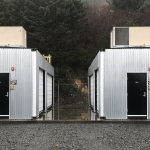The Energy Management System (EMS) is the project’s operating system, it is the software that is responsible for controls (charging and discharging), optimization (revenue and health) and safety (electrical and fire). Overall, the cost of an EMS is an insignificant part of the total system cost, however, the performance and capabilities of the EMS can have an outsized effect on project availability.
There are several EMS companies in the energy storage market, other than cost, the following differentiators should be considered prior to selecting a BESS and/or Solar EMS.
On Premise vs. Cloud Solution. Fractal EMS is an on-site solution with cloud data backup (air gapped). On-site controls are a requirement for large projects with NERC CIP policies.
Renewable Energy Integration. Very few BESS EMS providers also offer solar controls. Some offer just a dashboard in lieu of actual controls. In addition to BESS controls, Fractal EMS also offers solar-only controls, as well as AC and DC coupled PV+S.
Controller Capabilities. Some EMS companies cannot communicate with multiple container BMS behind a single inverter (they need a BMS aggregator to create a single connection). Fractal EMS can handle multiple connections and P/Q commands (e.g., 13 devices: 1 solar inverter, 6 DC converters, and 6 BMS).
Cyber Security Capabilities. EMS providers can have various VPN options, security frameworks and standards. Fractal EMS follows best practices from NIST 800-53, ISO 27001 and NERC/CIP and has in-house cyber security and IT expertise. Fractal EMS is also NERC CIP medium compliant in our remote 24/7 monitoring center.
Controller Hardware. Fractal EMS controllers are built to run real-time controls for power plants and have a mean time between failure of 40 years. Some EMS companies use cheap industrial PCs or use virtual machines running on one server (single point of failure).
Controller Installation Flexibility. Fractal EMS equipment is rated for at least -40 C to 70C. This means the equipment can be housed in field network enclosures (FNE), normally without thermal management.
Commissioning Time. Some EMS providers commission on time, some do not. This can create exposure to LDs for the contracting party, and missed market revenues. Fractal EMS has an excellent track record for commissioning projects on time.
Master Plant Controls. Some EMS providers also provide a Master Plant Controller (MPC) on top of hybrid (PV+S or Wind+S) projects. MPC is essential when there is more than one resource ID sharing an interconnection. Fractal EMS can provide a MPC that coordinates between solar, wind and/or BESS while maintaining interconnection requirements.
Point of Origin. The EMS provider may use equipment manufactured domestically or manufactured abroad. The point of origin for equipment may introduce cyber security concerns. Fractal EMS main equipment (controllers, network switches, SCADA devices, and servers) are domestically sourced.
Response Time. Response time varies across EMS companies. Controls latency (including metering and communication latency) can hinder participation in specific wholesale market applications that require fast response. Fractal EMS will identify and then issue a power command to the inverters in 49 ms. Fractal EMS has successful passed qualification and has assets under operations providing ERCOT FFR, CAISO Regulation, PJM RegD and AEMO FCAS.
Networking. Not all EMS providers can provide networking. Networking influences response time, availability and cyber security, thus it goes hand-in-hand with the EMS. Fractal EMS networking is performed in-house. Fractal designs, installs, tests, and commissions the network to include firewalls, VPNs, VLANs, and modems (including cellular backup).
SCADA Integration. Not all EMS providers can program SCADA (RTAC programming and SCADA layer integration via RTU – substation configuration and integration is especially difficult). Fractal EMS uses RTACs which serve as a protocol gateway to establish telemetry with entities outside of the EMS network. Fractal EMS RTAC programming is performed in-house.
Monitoring. Some EMS provides say they provide monitoring but they only monitor their controllers and Web Interface, not the entire BESS. Some providers off-shore monitoring and technical support to a third-party. Fractal EMS has options for business hours and 24/7 monitoring. Fractal EMS monitors the entire project, while providing round the clock technical support and troubleshooting from experience operators out of our Austin, Texas facility. The Fractal EMS remote operations center is NERC CIP compliant.
Domestic Content. Some EMS controllers use chips or printed circuit boards (PCBAs) manufactured in countries on the Foreign Entity of Concern (FOEC) list (e.g., China, Russia, and Iran). Fractal only uses chips from the USA or Europe. EMS can be complimented with Fractal’s U.S. made Battery Management System (BMS) with advanced chip technology to increase cybersecurity and create the ability to perform remote updates.
Availability / Uptime. Some EMS companies start the clock on “notification of downtime” and some start the clock at the downtime event. Fractal EMS provides a base 98% Availability Guarantee starting from the downtime event. As an option, this guarantee can increase to 99.5%.
Speed of Integration with New Suppliers. The number of man-hours required to integrate with new make/models of batteries and PCSs significantly varies across EMS providers. Most vendors take 2-3 months to integrate with a new equipment vendor. Fractal EMS takes 2-3 weeks.
Data Capture and Retention. The periodicity of data capture (1-10 sec) and data retention (1-5 years) can vary drastically across EMS providers. Fractal EMS captures all data once per second (with the ability to capture 20 parameters at 100 times per second). Fractal EMS stores the data for a minimum of 5 years.
Remote O&M. Does the EMS provider offer operations and monitoring (or are they outsourcing it)? To achieve high uptime, it is critical to have experience engineers troubleshoot and restore the BESS. Some EMS providers charge for monitoring but they are only monitoring their devices and software, not the entire plant. Fractal EMS has a remote operations center (ROC) located in Austin, TX and monitors the entire asset. The ROC is staffed by former Navy Nuclear engineers. The Fractal EMS staff has 12 years of O&M experience (including preventative and corrective maintenance).
Bid Optimization. Some EMS providers provide bid optimization and scheduling services to support wholesale market participation. There are significant variations in commercial terms, cost and effectiveness (50 to 90% of perfect) across market players. Fractal Optimization service has outperformed other players in the market across competitive trials. The service includes RT and DAM forecasts, optimized offer curves, settlement summaries and weekly performance reports.
Software Team and Capabilities. Some EMS providers outsource software development overseas or have limited in-house capabilities which can introduce vulnerabilities or limit development progress. Fractal’s EMS software team is in-house. This enables fast response when an issue is discovered.
Historian. Ease of access and ability to visualize data can vary across EMS providers. Fractal EMS provides an on-site and off-site historian to enable troubleshooting and analytics. The off-site historian is for storage of warranty data.
HMI Features. The HMI experience (features and usability) varies across EMS providers. Some owners may need robust reporting, analytics and dashboards. Fractal EMS has industry leading dashboards, reporting and analytics. Plus, all these features are accessible with one login.
Company Resources. Some EMS providers may not have enough headcount or redundancy to support several concurrent projects. Fractal EMS has multiple teams that can integrate concurrent projects.
BMS Deficiencies. Some BMS lack protections, features, and/or p-limiting capabilities. Fractal has experience building BMS, hence Fractal EMS can add missing BMS features.
Pricing. Most EMS providers are priced similarly (the typical difference is about one day of Delay LDs). Fractal EMS provides straight forward pricing with a history of on-time COD.
If you are experience commissioning / operational issues, or would like a demo, please contact us at info@fractalems.com.
Read More









